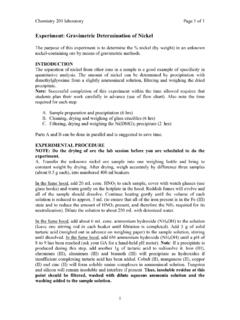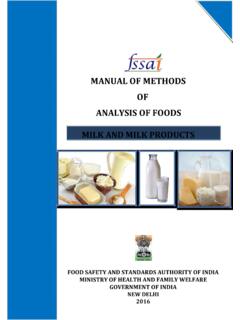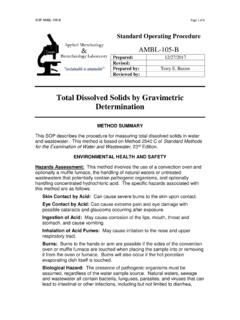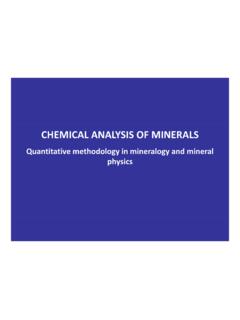Transcription of General methods for sampling and gravimetric analysis of …
1 Introduction1 This procedure aims to guide those who wish to collect the respirable, thoracic and inhalable aerosol fractions in air for the purpose of monitoring workplace exposure. It also describes analysis of the fractions using the gravimetric Materials hazardous to health often occur in the workplace in the form of aerosols. The term aerosol is used to describe any suspension of particles in air, whether they constitute dust, fibres, fume, smoke or liquid droplets. Most aerosols consist of a wide range of particle diameters. 3 The behaviour, deposition and fate of any particle after entry into the human respiratory system are determined by the chemical nature and size of the particle. For occupational hygiene purposes it is important to consider the concentration and the size fractions present. 4 It is possible to define aerosol size fractions that relate to the region of the respiratory tract where they deposit.
2 The convention for these size fractions are described in ISO 77081 or BS EN These are the inhalable, thoracic and respirable size fractions:(a) Inhalable fraction this approximates to the fraction of airborne material that enters the nose and mouth during breathing, and is therefore available for deposition anywhere in the respiratory tract. (b) Thoracic fraction this is the fraction of inhaled airborne material penetrating beyond the larynx. (c) Respirable fraction this is the inhaled airborne material that penetrates to the lower gas exchange region of the Advice on the relevant size fraction to be measured for a particular material hazardous to health may be obtained from EH40/2005 Workplace exposure limits3 and the Approved Code of Practice on the COSHH The methods described in this MDHS are suitable for the measurement of exposure to the health-related concentrations of most aerosols in the workplace.
3 In some instances alternative methods exist (eg welding fume,5 colophony6 and isocyanates7) and you should refer to these specific methods . For some materials a specific sampler is required (eg IOM sampler is the preferred sampler for cotton dust4) to reliably perform the analysis . The use of alternative methods is acceptable provided that the accuracy and reliability appropriate to the application can be and Safety ExecutiveGeneral methods for sampling and gravimetric analysis of respirable, thoracic and inhalable aerosolsMethods for the Determination of Hazardous Substances Health and Safety LaboratoryGeneral methods for sampling and gravimetric analysis of respirable, Page 2 of 13 Health and Safety Executivethoracic and inhalable aerosols7 This procedure describes the analysis of the collected aerosol using the gravimetric technique. After drawing a measured volume of air through the pre-weighed collection medium (eg filter or foam) mounted in a suitable particle size-selective sampler, the mass concentration can then be determined from the mass of the aerosol collected and the sampled air Where further analysis for specific constituents is required, refer to the appropriate methods to ensure the sampling medium is compatible with the analysis sampling 9 Air monitoring should be representative of the working periods of the individuals exposed.
4 General guidance on workplace monitoring is given in Monitoring strategies for toxic substances (HSG173).8 10 A longer sampling time ensures a heavier deposit and reduces potential weighing inaccuracies. So sampling times should be as long as is reasonably practicable: (a) The maximum sampling time should be the entire shift, and 15 minutes for short-term samples. Task-specific sampling should cover the period of the task being performed. (b) For an 8-hour time-weighted average (TWA) estimation of exposure, the minimum sampling period should be at least 25% of the shift,8 though it is preferable if sampling times are no less than four hours. 11 To avoid sampler overloading where dust concentrations are high, several consecutive samplers should be employed for comparison with workplace exposure limits (WELs), though enough information may be obtained from one sample. 12 When employing fixed-point sampling , the samplers should be positioned at approximately head height, away from obstructions, fresh-air inlets or strong winds.
5 The sampling procedures are otherwise the same as for personal Users of this procedure will need to be familiar with the content of Occupational exposure limits (EH40),3 Monitoring strategies for toxic substances (HSG173)8 and BS ISO 14 Users of this procedure should carry out a suitable risk assessment. It is the user s responsibility to establish appropriate health and safety practices and to ensure compliance with regulatory sampling equipment15 Use a suitable sampler (see the Appendix) capable of performing according to the required size fraction of interest (inhalable, thoracic or respirable).1,2 Samplers General methods for sampling and gravimetric analysis of respirable, Page 3 of 13 Health and Safety Executivethoracic and inhalable aerosolsshould be pre-cleaned, checked for defects and operated according to the manufacturer s instructions. 16 Some samplers are designed to sample multiple size fractions within one sampler and are termed multi-fraction samplers.
6 Commercially available samplers and references to published reports on their performance are given in PD CEN/TR In instances where workers wear face visors, lapel- or collar-mounted samplers are effectively outside the breathing zone of the worker. The face level sampler11 is designed to measure manganese in welding aerosol according to ISO It allows exposure measurements to be made close to the worker s mouth and can also be worn comfortably inside face visors. It can also be used for the analysis of other metals in welding aerosol and gravimetric analysis of welding aerosol, but with reduced sampling efficiency for particles larger than 20 media18 The choice of collection medium (eg filter, foam or impaction plate) will be dictated by the type of sampler, the sampler flow rate and by analytical In some sampler designs the collection media are held in cassettes and these can be weighed together (see the Appendix for additional information on plastic cassettes).
7 In other samplers the collection medium may be held within a holder that is not intended to be weighed. The manufacturer s operating instructions should be consulted on which parts of the sampler should be included in the gravimetric For gravimetric measurements, glass fibre filters are commonly used, but if further chemical analysis of the collected material is required then this may determine the type of collection medium Fibre loss from glass fibre filters may occur during handling and could be significant if not weighed within a cassette. Consider using membrane filters to alleviate this issue. 22 Some filter materials (eg cellulose nitrate) can show excessive weight change due to moisture absorption, and other types (eg PVC, PTFE) can show excessive static build-up. Filters of mixed esters of cellulose have reduced susceptibility to these factors. 23 For membrane filters, the choice of filter pore size will depend on the size fraction of the aerosol being collected and the sampler flow rate.
8 It is recommended that the largest pore size possible be used to minimise the pressure drop across the filter. Consult the manufacturer or analyst for the optimum filter for the particular application. Other equipment24 A balance should be calibrated against a primary standard for weighing the sampling media. The balance should be capable of weighing to a precision of at least 10 g, and preferably 1 g. The balance should be checked against a calibrated standard weight traceable to International Standards at the intervals recommended by the manufacturer and immediately before weighing sampling media. Ideally, the balance should be placed on an anti-vibration methods for sampling and gravimetric analysis of respirable, Page 4 of 13 Health and Safety Executivethoracic and inhalable aerosols25 The balance and sampling media to be weighed should be placed in a room with temperature and humidity controls within the range specified by the balance manufacturer.
9 BS ISO 157679 states that the humidity should be constant within 5% and the temperature 2 C. 26 Use a static eliminator when weighing Use flat-tipped forceps for handling Use filter tins or sampler cassettes, transport clips and a transport container to safely transport samples from the site to the analytical laboratory. 29 Personal sampling pumps that meet the requirements of BS EN ISO 1313712 should be operated according to the manufacturer s instructions. sampling pumps should have the following features as a minimum:(a) an automatic flow control which keeps the volumetric flow rate within in case of changing back pressure caused by filter loading;(b) either a malfunction indicator, which following the completion of sampling , indicates that the air flow has been reduced or interrupted during sampling , or an automatic cut-out, which stops the pump flow if it is reduced or interrupted;(c) a facility for adjustment of the flow rate that prevents inadvertent adjustment during use;(d) pulsation damped flow for cyclone Flexible plastic tubing should have a suitable diameter for making a leak proof connection from the sampling head to the pump.
10 For personal sampling , belts or harnesses should allow sampling apparatus to be There should be a portable flow meter, calibrated against a primary standard at the flow rates of interest, with a measurement uncertainty less than A suitable adapter needs to connect the sampling head and the flow meter in order to set the flow rate through the sampler A timer should determine the pump on/off times. Preparation and sampling Substrate weighing Procedure for pre- and post- sampling media (in cassettes where used)34 It is recommended that the weighing procedure be documented to ensure consistency of Prior to sampling , sufficient sample collection media should be placed in suitable containers, with lids ajar and left to equilibrate overnight in the balance room. Some substrates or cassettes may take longer to equilibrate. For the majority of air samples and media, overnight conditioning is satisfactory but some substrates or cassettes may take much longer to equilibrate.


















